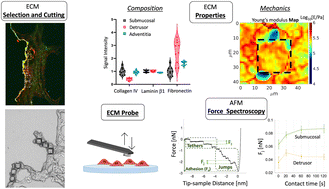Native extracellular matrix probes to target patient- and tissue-specific cell–microenvironment interactions by force spectroscopy†
Abstract
Atomic Force Microscopy (AFM) is successfully used for the quantitative investigation of the cellular mechanosensing of the microenvironment. To this purpose, several force spectroscopy approaches aim at measuring the adhesive forces between two living cells and also between a cell and an appropriate reproduction of the extracellular matrix (ECM), typically exploiting tips suitably functionalised with single components (e.g. collagen, fibronectin) of the ECM. However, these probes only poorly reproduce the complexity of the native cellular microenvironment and consequently of the biological interactions. We developed a novel approach to produce AFM probes that faithfully retain the structural and biochemical complexity of the ECM; this was achieved by attaching to an AFM cantilever a micrometric slice of native decellularised ECM, which was cut by laser microdissection. We demonstrate that these probes preserve the morphological, mechanical, and chemical heterogeneity of the ECM. Native ECM probes can be used in force spectroscopy experiments aimed at targeting cell–microenvironment interactions. Here, we demonstrate the feasibility of dissecting mechanotransductive cell–ECM interactions in the 10 pN range. As proof-of-principle, we tested a rat bladder ECM probe against the AY-27 rat bladder cancer cell line. On the one hand, we obtained reproducible results using different probes derived from the same ECM regions; on the other hand, we detected differences in the adhesion patterns of distinct bladder ECM regions (submucosa, detrusor, and adventitia), in line with the disparities in composition and biophysical properties of these ECM regions. Our results demonstrate that native ECM probes, produced from patient-specific regions of organs and tissues, can be used to investigate cell–microenvironment interactions and early mechanotransductive processes by force spectroscopy. This opens new possibilities in the field of personalised medicine.



 Please wait while we load your content...
Please wait while we load your content...